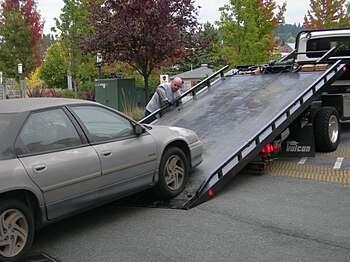There is a wide variety of motor vehicles traveling on and off roads, all of them susceptible to mechanical failure or accidents which may leave them incapacitated and in need of tow. Even vehicles in perfect working order are sometimes towed rather than driven (for example, when a family relocates and want to have their vehicle delivered to their new place of residents).
Due to the infinite possible types of circumstances it is not surprising that there are several types of tow trucks and towing methods. Using the most befitting towing method in each specific case is of great importance.

A car being loaded onto a flatbed tow truck (Photo credit: Wikipedia)
In the following paragraphs you will find a summary of the different methods of towing currently in use along with a brief description of their relative advantages and disadvantages and the way these determine the circumstances in which each method becomes the most suitable one.
Types of Tow Trucks
There are several tow truck manufacturers and a wide range of models which differ greatly from each other, but still, tow trucks can still be divided into three basic types:
• Wheel lift tow trucks
• Hook and chain tow trucks
• Flatbed tow trucks
Tow trucks belonging of the wheel lift type use steel yokes which are hooked and secured under the back or front axles of the towed vehicle. Using hydraulic power (produced by a hydraulic pump driven by the tow truck’s engine) the yoke is raised and lifts the end under which it is attached clear off the ground. The towed vehicle remains with two of its wheels in contact with the road. This method of towing is also commonly referred to as “tow by dolly” or “dolly towing”.
Posted under Car Tips
This post was written by admin on December 30, 2014




